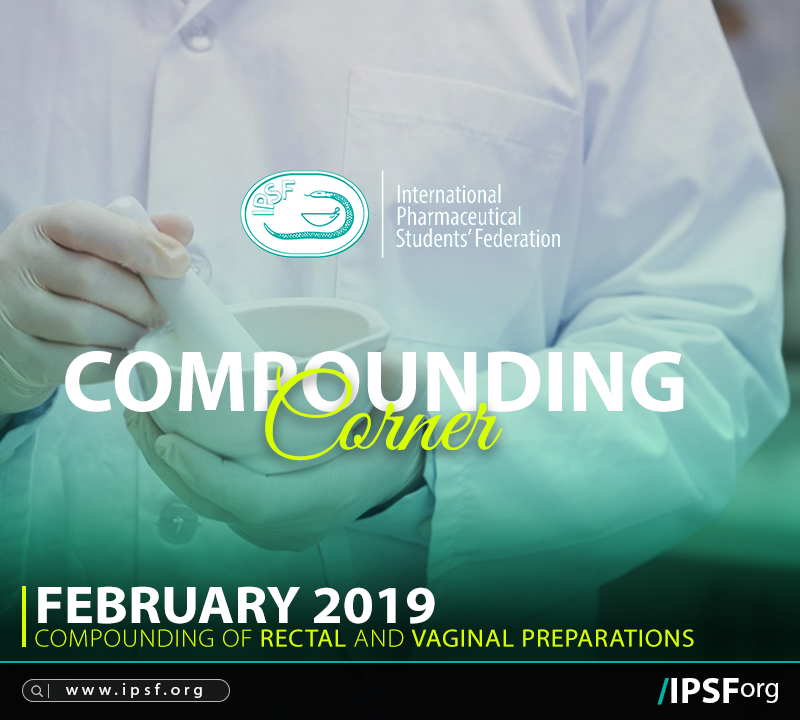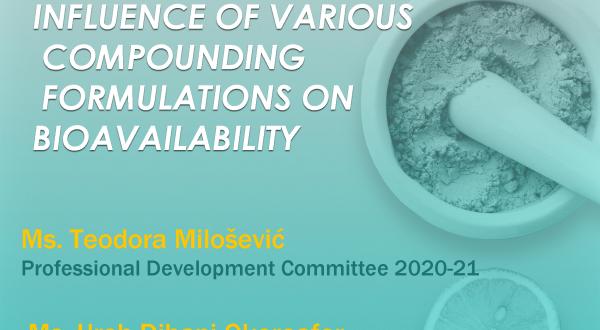
Compounding of Rectal and Vagina Preparations (February 2019)
Rectal preparations
Rectal preparations commonly include suppositories, solutions, and ointments. Suppositories are solid dosage forms of various shapes and sizes that are suitable for introduction into body cavities. They dissolve in the mucous secretions or melt at body temperature allowing the release of the medication locally and systemically. Drugs administered via the rectum are given for a local effect or to exert a systemic effect. Local effects may include the soothing of inflamed hemorrhoidal tissues, or facilitating the emptying of the lower bowel. Using rectal administration to exert systemic effect is sought to avoid hepatic first-pass metabolism or gastrointestinal degradation or when oral administration is not possible due to vomiting or swallowing difficulty. Rectal suppositories for adults usually weigh about 2 grams while infant rectal suppositories usually weight about 1 gram or about half that of adult suppositories.
Vaginal preparations
Vaginal preparations include solutions, powders for solutions, ointments, creams, aerosol foams, suppositories, and tablets. Vaginal suppositories (or pessaries) can be used as contraceptives, feminine hygiene antiseptics, bacterial antibiotics, or to restore the vaginal mucosa. Vaginal suppositories are usually oval-shaped and weigh between 3 - 5 grams.
Suppository Bases
Suppository bases should be non-toxic, non-irritating, inert, compatible with the active ingredients, and easily formed by compression or molding. Suppository base composition plays an important role in both the rate and extent of release of medications. Suppository bases can be classified as according to their composition and physical properties
Oleaginous (fatty or hydrophobic) bases
Oleaginous bases include theobroma oil (also called cocoa butter) and synthetic triglyceride mixtures. At ordinary room temperatures of 15°C-25°C (59°F-77°F), theobroma oil is a hard amorphous solid, while at 30°C-35°C (86°F-95°F)/ body temperature, it melts readily to a bland, non-irritating oil. However as it is a polymorphic compound and if overheated, theobroma oil will convert to a metastable structure that melts in the 25°C-30°C (77°-86°F) range. Thus, the finished suppositories would melt at room temperature and not be usable. Synthetic triglycerides consist of hydrogenated vegetable oils such as palm kernel oil and cottonseed oil, and have the advantage of not exhibiting polymorphism.
Water soluble (water miscible) bases
Water soluble bases are those containing glycerinated gelatin or polyethylene glycol (PEG) polymers. They release the drug by dissolving in the aqueous body fluids. The formulation do not need to melt at body temperature, so water soluble suppositories can be formulated with much higher melting points and thus may be safely stored at room temperature.
Glycerinated Gelatin is particularly used for vaginal suppositories. Glycerinated gelatin suppositories tend to disperse slowly in mucous secretions thus to provide prolonged release of active ingredients. However, as the glycerinated base tend to absorb moisture due to its hygroscopic nature, these suppositories must be kept in well-closed containers.
PEG are available in a large range of molecular weight and can be formulated in a wide range of hardness and dissolution time. bases have many desirable properties,
Methods of Preparation
Suppositories can be extemporaneously prepared by different methods:
Hand Rolling is the oldest and simplest method of suppository preparation. It may be used when only a few suppositories are to be prepared in a cocoa butter base. Grated cocoa butter and active ingredients are triturated in a mortar. The mass is then rolled with a large spatula into a uniform cylinder which is then cut into the appropriate number of pieces that are rolled on one end to produce a conical shape.
Compression Molding is a method of preparing suppositories from a mixed mass of grated suppository base and medicaments which is forced into a special compression mold. The method requires that the capacity of the molds first be determined by compressing a small amount of the base into the dies and weighing the finished suppositories. When active ingredients are added, it is necessary to omit a portion of the suppository base, based on the density factors of the active ingredients.
Fusion Molding involves first melting the suppository base, and then dispersing or dissolving the drug in the melted base. The mixture is removed from the heat and poured into a suppository mold. When the mixture has congealed, the suppositories are removed from the mold. The fusion method can be used with all types of suppositories and must be used with most of them.
Example case
You receive the following prescription in your pharmacy:
Patient : Susan H.
Age: 25
Sex: F
Prescription: 3 x 8g Ichthammol Pessaries 5% using the following formula:
Ichthammol Pessaries 5%
Glycero-gelatin base 95%
Directions: Insert ONE pessary into the vagina when required.
Note: formula for preparing the Glycero-gelatin base
Gelatin 14%
Glycerol 70%
Purified water to 100 %
Questions:
1. What is the use of this product?
2. Explain the role of the components in this preparation.
3. In compounding this prescription, you calculate for two extra suppositories to account for unavoidable loss in compounding. Calculations are therefore based on the amounts required to prepare 5 pessaries. What is the mass of base that would be needed to prepare 5 pessaries ? (The glycero-gelatin base has a density of 1.2. To correctly calculate the quantities required, the amount that would be required to fill the nominal weight will need to be multiplied by a factor of 1.2.)
4. How many grams of gelatin, of glycerol are required for preparing 50 g of base?
5. What is the volume of purified water used in this preparation?
6. How many grams of ichtammol is used for the preparation of the pessaries?
7. Which method is used for preparing the pessaries?
8. What precautions should be taken when choosing the container of the suppositories?
9. What are the labelling considerations for this preparation? Sample label.
10. What advice do you give to the patient?
Answers :https://www.ipsf.org/answers-february-compounding-corner



